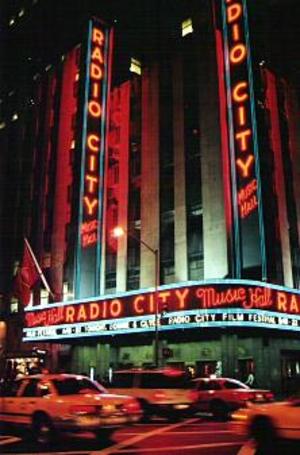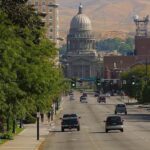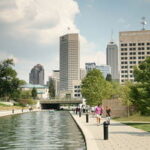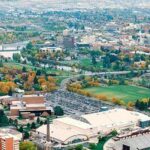Based on the most recent estimates from the U.S. Census Bureau, this article lists the twenty-five largest U.S. cities by population size and provides demographic details for each city–total population, population by age group, racial composition of the population, land area, and population density.
After reading “Largest U.S. Cities: Population Size (2012),” return to these links to access similar articles for the largest cities in each of the 50 states: Alabama, Alaska, Arizona, Arkansas, California, Colorado, Connecticut, Delaware, Florida, Georgia, Hawaii, Idaho, Illinois, Indiana, Iowa, Kansas, Kentucky, Louisiana, Maine, Maryland, Massachusetts, Michigan, Minnesota, Mississippi, Missouri, Montana, Nebraska, Nevada, New Hampshire, New Jersey, New Mexico, New York, North Carolina, North Dakota, Ohio, Oklahoma, Oregon, Pennsylvania, Rhode Island, South Carolina, South Dakota, Tennessee, Texas, Utah, Vermont, Virginia, Washington, West Virginia, Wisconsin, and Wyoming.
1. Largest U.S. Cities: Population Size (2012) – New York City, NY
Located in southeastern New York, New York City is the largest U.S. city with an estimated population of 8,391,881.
Grouped by age, 23.0% of the population is under 18, 9.7% is 18 to 24, 30.9% is 25 to 44, 24.1% is 45 to 64, and 12.3% is 65 or older. The median age of the population is 36.3.
The racial composition of the city is 44.6% White, 25.1% Black or African American, 0.4% Native American, 11.8% Asian, 0.1% Pacific Islander, 16.0% from other races, and 2.1% from two or more races. The population is 27.5% Hispanic or Latino of any race.
The land area of the city is 303.31 square miles. The city’s population density is 27,391.66 people per square mile.
2. Largest U.S. Cities: Population Size (2012) – Los Angeles, CA
Located in southwestern California, Los Angeles is the second largest U.S. city with an estimated population of 3,831,868.
Grouped by age, 24.8% of the population is under 18, 11.1% is 18 to 24, 31.7% is 25 to 44, 22.2% is 45 to 64, and 10.2% is 65 or older. The median age of the population is 33.9.
The racial composition of the city is 49.5% White, 9.9% Black or African American, 0.6% Native American, 10.4% Asian, 0.2% Pacific Islander, 26.5% from other races, and 2.9% from two or more races. The population is 48.4% Hispanic or Latino of any race.
The land area of the city is 469.07 square miles. The city’s population density is 7,992.53 people per square mile.
3. Largest U.S. Cities: Population Size (2012) – Chicago, IL
Located in northeastern Illinois, Chicago is the third largest U.S. city with an estimated population of 2,851,268.
Grouped by age, 24.2% of the population is under 18, 11.1% is 18 to 24, 31.9% is 25 to 44, 22.4% is 45 to 64, and 10.4% is 65 or older. The median age of the population is 33.9.
The racial composition of the city is 39.9% White, 34.6% Black or African American, 0.2% Native American, 4.9% Asian, 18.6% from other races, and 1.7% from two or more races. The population is 27.8% Hispanic or Latino of any race.
The land area of the city is 227.13 square miles. The city’s population density is 11,998.44 people per square mile.
4. Largest U.S. Cities: Population Size (2012) – Houston, TX
Located in the central part of eastern Texas, Houston is the fourth largest U.S. city with an estimated population of 2,257,926.
Grouped by age, 26.7% of the population is under 18, 10.1% is 18 to 24, 31.3% is 25 to 44, 23.0% is 45 to 64, and 8.9% is 65 or older. The median age of the population is 32.8.
The racial composition of the city is 53.8% White, 24.1% Black or African American, 0.4% Native American, 5.3% Asian, 0.1% Pacific Islander, 15.2% from other races, and 1.1% from two or more races. The population is 41.9% Hispanic or Latino of any race.
The land area of the city is 579.42 square miles. The city’s population density is 3,493.80 people per square mile.
5. Largest U.S. Cities: Population Size (2012) – Phoenix, AZ
Located in the southwestern part of central Arizona, Phoenix is the fifth largest U.S. city with an estimated population of 1,593,659.
Grouped by age, 29.0% of the population is under 18, 9.3% is 18 to 24, 32.1% is 25 to 44, 21.9% is 45 to 64, and 7.7% is 65 or older. The median age of the population is 31.9.
The racial composition of the city is 77.2% White, 5.4% Black or African American, 1.9% Native American, 2.5% Asian, 0.2% Pacific Islander, 10.9% from other races, and 1.9% from two or more races. The population is 42.1% Hispanic or Latino of any race.
The land area of the city is 517.13 square miles. The city’s population density is 2,839.97 people per square mile.
6. Largest U.S. Cities: Population Size (2012) – Philadelphia, PA
Located in southeastern Pennsylvania, Philadelphia is the sixth largest U.S. city with an estimated population of 1,547,297.
Grouped by age, 25.1% of the population is under 18, 10.9% is 18 to 24, 27.3% is 25 to 44, 23.8% is 45 to 64, and 12.9% is 65 or older. The median age of the population is 35.5.
The racial composition of the city is 42.5% White, 43.5% Black or African American, 0.3% Native American, 5.5% Asian, 0.1% Pacific Island, 6.4% from other races, and 1.8% from two or more races. The population is 11.0% Hispanic or Latino of any race.
The land area of the city is 135.09 square miles. The city’s population density is 10,725.52 people per square mile.
7. Largest U.S. Cities: Population Size (2012) – San Antonio, TX
Situated in the southern part of central Texas, San Antonio is the seventh largest U.S. city with an estimated population of 1,373,668.
Classified by age, 27.8% of the population is under 18, 10.9% is 18 to 24, 28.6% is 25 to 44, 22.3% is 45 to 64, and 10.4% is 65 or older. The median age of the population is 32.6.
The racial complexion of the city is 68.9% White, 6.6% Black or African American, 0.6% Native American, 2.0% Asian, 0.1% Pacific Islander, 19.4% from other races, and 2.4% from two or more races. The population is 61.2% Hispanic or Latino of any race.
The land area of the city is 407.56 square miles. The city’s population density is 3,134.07 people per square mile.
8. Largest U.S. Cities: Population Size (2012) – San Diego, CA
Situated in southwestern California, San Diego is the eighth largest U.S. city with an estimated population of 1,306,300.
Classified by age, 22.6% of the population is under 18, 12.9% is 18 to 24, 31.7% is 25 to 44, 22.2% is 45 to 64, and 10.6% is 65 or older. The median age of the population is 33.4.
The racial complexion of the city is 67.4% White, 6.7% Black or African American, 0.7% Native American, 14.7% Asian, 0.4% Pacific Islander, 6.5% from other races, and 3.6% from two or more races. The population is 27.3% Hispanic or Latino of any race.
The land area of the city is 324.34 square miles. The city’s population density is 3,857.63 people per square mile.
9. Largest U.S. Cities: Population Size (2012) – Dallas, TX
Located in northeastern Texas, Dallas is the ninth largest U.S. city with an estimated population of 1,299,542.
Categorized by age, 27.0% of the population is under 18, 9.4% is 18 to 24, 34.0% is 25 to 44, 21.2% is 45 to 64, and 8.4% is 65 or older. The median age of the population is 32.2.
The racial profile of the city is 56.6% White, 23.2% Black or African American, 0.4% Native American, 2.5% Asian, 0.1% Pacific Islander, 15.9% from other races, and 1.3% from two or more races. The population is 43.1% Hispanic or Latino of any race.
The land area of the city is 342.54 square miles. The city’s population density is 3,544.95 people per square mile.
10. Largest U.S. Cities: Population Size (2012) – San Jose, CA
Located in the western part of central California, San Jose is the tenth largest U.S. city with an estimated population of 964,695.
Categorized by age, 24.9% of the population is under 18, 9.6% is 18 to 24, 31.5% is 25 to 44, 24.4% is 45 to 64, and 9.6% is 65 or older. The median age of the population is 35.6.
The racial profile of the city is 48.6% White, 3.0% Black or African American, 0.6% Native American, 31.2% Asian, 0.4% Pacific Islander, 12.8% from other races, and 3.4% from two or more races. The population is 31.5% Hispanic or Latino of any race.
The land area of the city is 174.86 square miles. The city’s population density is 5,176.60 people per square mile.
11. Largest U.S. Cities: Population Size (2012) – Detroit, MI
Located in southeastern Michigan, Detroit is the eleventh largest U.S. city with an estimated population of 910,921.
Grouped by age, 28.5% of the population is under 18, 9.4% is 18 to 24, 27.4% is 25 to 44, 23.9% is 45 to 64, and 10.8% is 65 or older. The median age of the population is 34.1.
The racial composition of the city is 10.5% White, 83.0% Black or African American, 0.3% Native American, 1.0% Asian, 3.8% from other races, and 1.4% from two or more races. The population is 6.4% Hispanic or Latino of any race.
The land area of the city is 138.77 square miles. The city’s population density is 5,825.45 people per square mile.
12. Largest U.S. Cities: Population Size (2012) – San Francisco, CA
Situated in the northwestern part of central California, San Francisco is the twelfth largest U.S. city with an estimated population of 815,358.
Sorted by age, 14.6% of the population is under 18, 7.4% is 18 to 24, 37.2% is 25 to 44, 26.2% is 45 to 64, and 14.6% is 65 or older. The median age of the population is 40.
The racial makeup of the city is 54.5% White, 6.5% Black or African American, 0.4% Native American, 31.3% Asian, 0.4% Pacific Islander, 3.9% from other races, and 3.0% from two or more races. The population is 14.0% Hispanic or Latino of any race.
The land area of the city is 46.69 square miles. The city’s population density is 17,095.22 people per square mile.
13. Largest U.S. Cities: Population Size (2012) – Jacksonville, FL
Located in northeastern Florida, Jacksonville is the thirteenth largest U.S. city with an estimated population of 813,518.
Grouped by age, 26.0% of the population is under 18, 8.9% is 18 to 24, 28.7% is 25 to 44, 25.9% is 45 to 64, and 10.5% is 65 or older. The median age of the population is 36.
The racial composition of the city is 62.3% White, 30.1% Black or African American, 0.3% Native American, 3.5% Asian, 0.1% Pacific Islander, 1.8% from other races, and 1.9% from two or more races. The population is 6.2% Hispanic or Latino of any race.
The land area of the city is 757.68 square miles. The city’s population density is 1,061.84 people per square mile.
14. Largest U.S. Cities: Population Size (2012) – Indianapolis, IN
Located in central Indiana, Indianapolis is the fourteenth largest U.S. city with an estimated population of 807,584.
Grouped by age, 26.6% of the population is under 18, 8.2% is 18 to 24, 29.9% is 25 to 44, 24.5% is 45 to 64, and 10.8% is 65 or older. The median age of the population is 35.5.
The racial composition of the city is 66.6% White, 25.9% Black or African American, 0.2% Native American, 1.7% Asian, 3.4% from other races, and 2.1% from two or more races. The population is 7.0% Hispanic or Latino of any race.
The land area of the city is 365.1 square miles. The city’s population density is 2,175.33 people per square mile.
15. Largest U.S. Cities: Population Size (2012) – Austin, TX
Situated in central Texas, Austin is the fifteenth largest U.S. city with an estimated population of 786,386.
A comparatively large percentage of the population is college-aged: the city is home to the University of Texas. Sorted by age, 23.3% of the population is under 18, 13.6% is 18 to 24, 35.9% is 25 to 44, 20.7% is 45 to 64, and 6.5% is 65 or older. The median age of the population is 31.4.
The racial makeup of the city is 63.7% White, 8.2% Black or African American, 0.4% Native American, 5.5% Asian, 0.1% Pacific Islander, 19.8% from other races, and 2.3% from two or more races. The population is 35% Hispanic or Latino of any race.
The land area of the city is 251.52 square miles. The city’s population density is 2,969.29 people per square mile.
16. Largest U.S. Cities: Population Size (2012) – Columbus, OH
Located in central Ohio, Columbus is the sixteenth largest U.S. city with an estimated population of 769,332.
A comparatively large part of the population is college-aged: the city is home to Ohio State University. Grouped by age, 24.3% of the population is under 18, 12.6% is 18 to 24, 32.6% is 25 to 44, 21.8% is 45 to 64, and 8.7% is 65 or older. The median age of the population is 32.3.
The racial composition of the city is 65.4% White, 26.4% Black or African American, 0.2% Native American, 4.1% Asian, 1.4% from other races, and 2.4% from two or more races. The population is 4.5% Hispanic or Latino of any race.
The land area of the city is 210.27 square miles. The city’s population density is 3,468.73 people per square mile.
17. Largest U.S. Cities: Population Size (2012) – Fort Worth, TX
Located in the central part of northern Texas, Fort Worth is the seventeenth largest U.S. city with an estimated population of 727,577.
Arranged by age, 28.6% of the population is under 18, 10.0% is 18 to 24, 31.6% is 25 to 44, 21.4% is 45 to 64, and 8.4% is 65 or older. The median age of the population is 31.9.
The racial mix of the city is 63.0% White, 18.0% Black or African American, 0.5% Native American, 3.5% Asian, 13.2% from other races, and 1.8% from two or more races. The population is 33.8% Hispanic or Latino of any race.
The land area of the city is 292.54 square miles. The city’s population density is 2,237.27 people per square mile.
18. Largest U.S. Cities: Population Size (2012) – Charlotte, NC
Located in southwestern North Carolina, Charlotte is the eighteenth largest U.S. city with an estimated population of 704,422.
Grouped by age, 26.2% of the population is under 18, 9.5% is 18 to 24, 31.8% is 25 to 44, 24.2% is 45 to 64, and 8.3% is 65 or older. The median age of the population is 34.6.
The racial composition of the city is 55.5% White, 33.5% Black or African American, 0.4% Native American, 4.1% Asian, 0.1% Pacific Islander, 4.6% from other races, and 1.8% from two or more races. The population is 11.2% Hispanic or Latino of any race.
The land area of the city is 242.27 square miles. The city’s population density is 2,760.54 people per square mile.
19. Largest U.S. Cities: Population Size (2012) – Memphis, TN
Located in southwestern Tennessee, Memphis is the nineteenth largest U.S. city with an estimated population of 676,640.
Grouped by age, 26.8% of the population is under 18, 10.8% is 18 to 24, 27.4% is 25 to 44, 24.7% is 45 to 64, and 10.3% is 65 or older. The median age of the population is 33.8.
The racial composition of the city is 31.7% White, 62.6% Black or African American, 0.2% Native American, 1.7% Asian, 0.1% Pacific Islander, 2.7% from other races, and 1.1% from two or more races. The population is 5.0% Hispanic or Latino of any race.
The land area of the city is 279.32 square miles. The city’s population density is 2,303.20 people per square mile.
20. Largest U.S. Cities: Population Size (2012) – Boston, MA
Located in the central part of eastern Massachusetts, Boston is the twentieth largest U.S. city with an estimated population of 645,169.
Grouped by age, 18.9% of the population is under 18, 15.3% is 18 to 24, 35.1% is 25 to 44, 20.5% is 45 to 64, and 10.2% is 65 or older. The median age of the population is 33.1.
The racial composition of the city is 56.3% White, 23.5% Black or African American, 0.4% Native American, 8.2% Asian, 0.1% Pacific Islander, 8.5% from other races, and 3.1% from two or more races. The population is 16.1% Hispanic or Latino of any race.
The land area of the city is 48.43 square miles. The city’s population density is 12,659.21 people per square mile.
21. Largest U.S. Cities: Population Size (2012) – Baltimore, MD
Located in central Maryland, Baltimore is the twenty-first largest U.S. city with an estimated population of 637,418.
Grouped by age, 24.2% of the population is under 18, 11.2% is 18 to 24, 27.7% is 25 to 44, 25.0% is 45 to 64, and 11.9% is 65 or older. The median age of the population is 35.5.
The racial composition of the city is 31.9% White, 63.4% Black or African American, 0.2% Native American, 1.9% Asian, 0.9% from other races, and 1.6% from two or more races. The population is 2.6% Hispanic or Latino of any race.
The land area of the city is 80.80 square miles. The city’s population density is 7,912.66 people per square mile.
22. Largest U.S. Cities: Population Size (2012) – El Paso, TX
Located in western Texas, El Paso is the twenty-second largest U.S. city with an estimated population of 620,456.
Grouped by age, 30.3% of the population is under 18, 10.8% is 18 to 24, 25.3% is 25 to 44, 22.2% is 45 to 64, and 11.4% is 65 or older. The median age of the population is 32.3.
The racial composition of the city is 77.8% White, 3.1% Black or African American, 0.5% Native American, 1.2% Asian, 0.1% Pacific Islander, 15.1% from other races, and 2.2% from two or more races. The population is 80.0% Hispanic or Latino of any race.
The land area of the city is 249.08 square miles. The city’s population density is 2,382.75 people per square mile.
23. Largest U.S. Cities: Population Size (2012) – Seattle, WA
Located in the northwestern part of Washington, Seattle is the twenty-third largest U.S. city with an estimated population of 616,627.
Grouped by age, 15.0% of the population is under 18, 10.7% is 18 to 24, 37.3% is 25 to 44, 25.5% is 45 to 64, and 11.5% is 65 or older. The median age of the population is 36.7.
The racial composition of the city is 73.1% White, 7.1% Black or African American, 0.7% Native American, 13.2% Asian, 0.6% Pacific Islander, 1.2% from other races, and 4.2% from two or more races. The population is 6.1% Hispanic or Latino of any race.
The land area of the city is 83.87 square miles. The city’s population density is 7,352.18 people per square mile.
24. Largest U.S. Cities: Population Size (2012) – Denver, CO
Located in the northern part of central Colorado, Denver is the twenty-fourth largest U.S. city with an estimated population of 610,345.
Grouped by age, 24.4% of the population is under 18, 8.0% is 18 to 24, 34% is 25 to 44, 23.2% is 45 to 64, and 10.4% is 65 or older. The median age of the population is 35.3.
The racial composition of the city is 74.1% White, 9.6% Black or African American, 1.1% Native American, 3.3% Asian, 0.1% Pacific Islander, 9.2% from other races, and 2.5% from two or more races. The population is 34.1% Hispanic or Latino of any race.
The land area of the city is 153.35 square miles. The city’s population density is 3,811.95 people per square mile.
25. Largest U.S. Cities: Population Size (2012) – Nashville, TN
Situated in the northwestern part of central Tennessee, Nashville is the twenty-fifth largest U.S. city with an estimated population of 605,413.
Classified by age, 23.7% of the population is under 18, 9.4% is 18 to 24, 30.9% is 25 to 44, 25.2% is 45 to 64, and 10.8% is 65 or older. The median age of the population is 36.2.
The racial complexion of the city is 64.9% White, 27.9% Black or African American, 0.4% Native American, 3.1% Asian, 2.4% from other races, and 1.2% from two or more races. The population is 7.8% Hispanic or Latino of any race.
The land area of the city is 502.26 square miles. The city’s population density is 1,179.83 people per square mile.
Source(s):
“Population Estmates,” U.S. Census Bureau
“American Fact Finder” U.S. Census
“Population, Housing Units, Area, and Density: 2000,” U.S. Census Bureau







